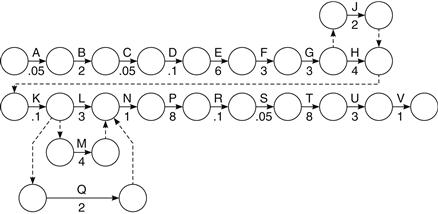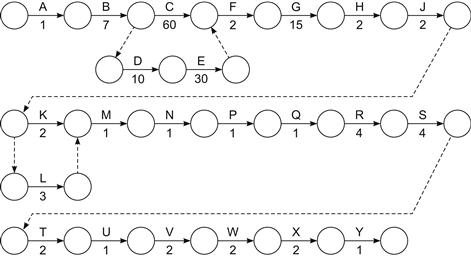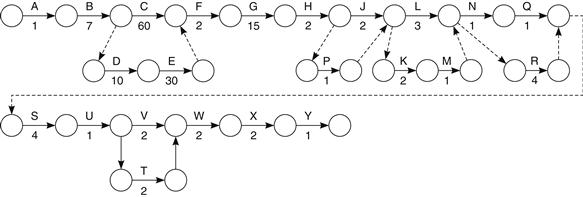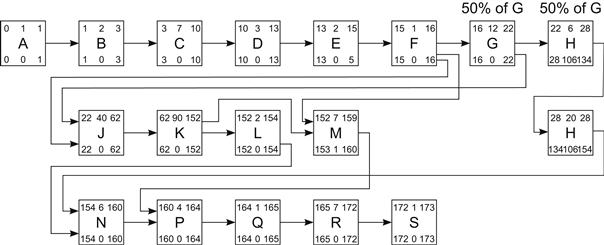Simple Examples
Abstract
In this chapter a number of small projects are scheduled and analyzed using both AoA and AoN manual methods. The examples given cover getting up in the morning, a loft conversion, a stock control system, and a small pipe bridge. The ability to reduce the overall construction time by these methods is clearly shown and dramatically so in the last example of the small pipe bridge.
Keywords
pipe bridge; Simple examples; small networks
Chapter Outline
To illustrate the principles set out in Chapter 20, let us now examine two simple examples.
Example 1
For the first example let us consider the rather mundane operation of getting up in the morning, and let us look at the constituent activities between the alarm going off and boarding our train to the office.
The list of activities – not necessarily in their correct sequence – is roughly as follows:
| Time (min) | ||
| A | switch off alarm clock | 0.05 |
| B | lie back and collect your thoughts | 2.0 |
| C | get out of bed | 0.05 |
| D | go to the bathroom | 0.10 |
| E | wash or shower | 6.0 |
| F | brush teeth | 3.0 |
| G | brush hair | 3.0 |
| H | shave (if you are a man) | 4.0 |
| J | boil water for tea | 2.0 |
| K | pour tea | 0.10 |
| L | make toast | 3.0 |
| M | fry eggs | 4.0 |
| N | serve breakfast | 1.0 |
| P | eat breakfast | 8.0 |
| Q | clean shoes | 2.0 |
| R | kiss wife goodbye | 0.10 |
| S | don coat | 0.05 |
| T | walk to station | 8.0 |
| U | queue and buy ticket | 3.0 |
| V | board train | 1.0 |
| 50.45 |
The operations listed above can be represented diagrammatically in a network. This would look something like that shown in Figure 26.1.

Figure 26.1
It will be seen that the activities are all joined in one long string, starting with A (switch off alarm) and ending with V (board train). If we give each activity a time duration, we can easily calculate the total time taken to perform the complete operation by simply adding up the individual durations. In the example given, this total time – or project duration – is 50.45 minutes. In theory, therefore, if any operation takes a fraction of a minute longer, we will miss our train. Consequently, each activity becomes critical and the whole sequence can be seen to be on the critical path.
In practice, however, we will obviously try to make up the time lost on an activity by speeding up a subsequent one. Thus, if we burn the toast and have to make a new piece, we can make up the time by running to the station instead of walking. We know that we can do this because we have a built-in margin or float in the journey to the station. This float is, of course, the difference between the time taken to walk and run to the station. In other words, the path is not as critical as it might appear, i.e., we have not in our original sequence – or network – pared each activity down to its minimum duration. We had something up our sleeve.
However, let us suppose that we cannot run to the station because we have a bad knee; how then can we make up lost time? This is where network analysis comes in. Let us look at the activities succeeding the making of toast (L) and see how we can make up the lost time of, say, two minutes. The remaining activities are:
| Times (min) | ||
| M | fry eggs | 4.0 |
| N | serve breakfast | 1.0 |
| P | eat breakfast | 8.0 |
| Q | clean shoes | 2.0 |
| R | kiss wife goodbye | 0.10 |
| S | don coat | 0.05 |
| T | walk to station | 8.0 |
| U | queue and buy ticket | 3.0 |
| V | board train | 1.0 |
| 27.15 |
The total time taken to perform these activities is 27.15 minutes.
The first question therefore is, have we any activity which is unnecessary? Yes. We need not kiss the wife goodbye. But this only saves us 0.1 minute, and the saving is of little benefit.
Besides, it could have serious repercussions. The second question must therefore be, are there any activities which we can perform simultaneously? Yes. We can clean our shoes while the eggs fry. The network shown in Figure 26.2 can thus be redrawn as demonstrated in Figure 26.3. The total now from M to V adds up to 25.15 minutes. We have, therefore, made up our lost two minutes without apparent extra effort. All we have to do is to move the shoe-cleaning box to a position in the kitchen where we can keep a sharp eye on the eggs while they fry.
![]()
Figure 26.2

Figure 26.3
Encouraged by this success, let us now re-examine the whole operation to see how else we can save a few minutes, since a few moments extra in bed are well worth saving. Let us therefore see what other activities can be performed simultaneously:
1. We could brush our teeth under the shower;
2. We could put the kettle on before we shaved so that it boils while we shave;
3. We could make the toast while the kettle boils or while we fry the eggs;
4. We could forget about the ticket and pay the ticket collector at the other end; or
5. We could clean our shoes while the eggs fry as previously discussed.
Having considered the above list, we eliminate (1) since it is not nice to spit into the bathtub, and (4) is not possible because we have an officious guard on our barrier. So we are left with (2), (3), and (5). Let us see what our network looks like now (Figure 26.4). The total duration of the operation or programme is now 43.45 minutes, a saving of seven minutes or over 13% for no additional effort. All we did was to resequence the activities. If we moved the washbasin near the shower and adopted the ‘brush your teeth while you shower’ routine, we could save another three minutes, and if we bought a season ticket we would cut another three minutes off our time. It can be seen, therefore, that by a little careful planning we could well spend an extra 13 minutes in bed – all at no extra cost or effort.

Figure 26.4
If a saving of over 25% can be made on such a simple operation as getting up, it is easy to see what tremendous savings can be made when planning complex manufacturing or construction operations.
Let us now look at our latest network again. From A to G the activities are in the same sequence as on our original network. H and J (shave and boil water) are in parallel. H takes four minutes and J takes two. We therefore have two minutes float on activity J in relation to H. To get the total project duration we must, therefore, use the four minutes of H in our adding-up process, i.e., the longest duration of the parallel activities.
Similarly, activities L, M, and Q are being carried out in parallel and we must, therefore, use M (fry eggs) with its duration of four minutes in our calculation. Activity L will, therefore, have one minute float while activity Q has two minutes float. It can be seen, therefore, that activities H, L, and Q could all be delayed by their respective floats without affecting the overall programme. In practice, such a float is absorbed by extending the duration to match the parallel critical duration or left as a contingency for disasters. In our example it may well be prudent to increase the toast-making operation from three minutes to four by reducing the flame on the grill in order to minimize the risk of burning the bread!
Example 2
Let us now look at another example. Suppose we decide to build a new room into the loft space of our house. We decide to coordinate the work ourselves because the actual building work will be carried out by a small jobbing builder, who has little idea of planning, while the drawings will be prepared by a freelance architect who is not concerned with the meaning of time. If the start of the programme is the brief to the architect and the end is the fitting of carpets, let us draw up a list of activities we wish to monitor to ensure a speedy completion of the project. The list would be as follows:
| Days | ||
| A | brief architect | 1 |
| B | architect produces plans for planning permission | 7 |
| C | obtain planning permission | 60 |
| D | finalize drawings | 10 |
| E | obtain tenders | 30 |
| F | adjudicate bids | 2 |
| G | builder delivers materials | 15 |
| H | strip roof | 2 |
| J | construct dormer | 2 |
| K | lay floor | 2 |
| L | tile dormer walls | 3 |
| M | felt dormer roof | 1 |
| N | fit window | 1 |
| P | move CW tank | 1 |
| Q | fit doors | 1 |
| R | fit shelves and cupboards | 4 |
| S | fit internal lining and insulation | 4 |
| T | lay electric cables | 2 |
| U | cut hole in existing ceiling | 1 |
| V | fit stairs | 2 |
| W | plaster walls | 2 |
| X | paint | 2 |
| Y | fit carpets | 1 |
| 156 |
Rather than draw out all these activities in a single long string, let us make a preliminary analysis on which activities can be carried out in parallel. The following immediately spring to mind:
1. Final drawings can be prepared while planning permission is obtained.
2. It may even be possible to obtain tenders during the planning permission period, which is often extended.
The preliminary network would, therefore, be as shown in Figure 26.5.

Figure 26.5
If all the activities were carried out in series, the project would take 156 days. As drawn in Figure 26.5 the duration of the project is 114 days. This shows already a considerable saving by utilizing the planning permission period for finalizing drawings and obtaining tenders.
However, we wish to reduce the overall time even further, so we call the builder in before we start work and go through the job with him. The first question we ask is how many men he will employ. He says between two and four. We then make the following suggestions:
1. Let the electrician lay the cables while the joiners fit the stairs.
2. Let the plumber move the tank while the roof of the dormer is being constructed.
3. Let the glazier fit the windows while the joiner fits the shelves.
4. Let the roofer felt the dormer while the walls are being tiled.
The builder may object that this requires too many men, but you can tell him that his overall time will be reduced and he will probably gain in the end. The revised network is, therefore, shown in Figure 26.6. The total project duration is now reduced to 108 days. The same network in precedence format (AoN) is shown in Figure 26.7.

Figure 26.6
If we now wish to reduce the period even further, we may have to pay the builder a little extra. However, let us assume that time is of the essence since our rich old uncle will be coming to stay and an uncomfortable night on the sofa in the sitting room might prejudice our chances in his will. It is financially viable, therefore, to ensure that the room will be complete.
Suppose we have to cut the whole job to take no longer than 96 days. Somehow we have to save another 12 days. First, let us look at those activities that have float. N and Q together take two days while R takes four. N and Q have, therefore, two days float. We can utilize this by splitting the operation S (fit internal lining) and doing two days’ work while the shelves and cupboards are being built. The network of this section would, therefore, appear as in Figure 26.8. We have saved two days provided that labour can be made available to start insulating the rafters.

Figure 26.8
If we adjudicate the bids (F) before waiting for planning permission, we can save another two days. This section of the network will, therefore, appear as in Figure 26.9.

Figure 26.9
Total saving to this stage is 2 + 2 = 4 days. We have to find another eight days, so let us look at the activities that take longest: C (obtaining planning permission) cannot be reduced since it is outside our control. It is very difficult to hurry a local authority. G (builder delivers materials) is difficult to reduce since the builder will require a reasonable mobilization period to buy materials and allocate resources. However, if we select the builder before planning permission has been received, and we do, after all, have 18 days float in loop D-E-F, we may be able to get him to place preliminary orders for the materials required first, and thus enable work to be started a little earlier. We may have to guarantee to pay the cost for this material if planning permission is not granted, but as time is of the essence we are prepared to take the risk. The saving could well be anything from one to 15 days.
Let us assume we can realistically save five days. We have now reduced the programme by 2 + 2 + 5 = 9 days. The remaining days can now only be saved by reducing the actual durations of some of the activities. This means more resources and hence more money. However, the rich uncle cannot be put off, so we offer to increase the contract sum if the builder can manage to reduce V, T, W, and X by one day each, thus saving three days altogether. It should be noted that we only save three days although we have reduced the time of four activities by one day each. This is, of course, because V and T are carried out in parallel, but our overall period – for very little extra cost – is now 96 days, a saving of 60 days, or 38%.
Example 3
This example from the IT industry uses the AoN (precedence) method of network drafting. This is now the standard method for this industry, probably because of the influence of MS Project and because networks in IT are relatively small compared to the very large networks in construction, which can have between two hundred and several thousand activities. The principles are of course identical.
A supermarket requires a new stock control system linked to a new check-out facility. This involves removing the existing check-out, designing and manufacturing new hardware, and writing new software for the existing computer, which will be retained.
The main activities and durations (all in days) for this project are as follows:
| Days | ||
| A | obtain brief from client (the supermarket owner) | 1 |
| B | discuss the brief | 2 |
| C | conceptual design | 7 |
| D | feasibility study | 3 |
| E | evaluation | 2 |
| F | authorization | 1 |
| G | system design | 12 |
| H | software development | 20 |
| J | hardware design | 40 |
| K | hardware manufacture | 90 |
| L | hardware delivery (transport) | 2 |
| M | removal of existing check-out | 7 |
| N | installation of new equipment | 6 |
| P | testing on site | 4 |
| Q | handover | 1 |
| R | trial operation | 7 |
| S | close out | 1 |
The network for this project is shown in Figure 26.10, from which it can be seen that there are virtually no parallel activities, so only two activities, M (Removal of existing check-out) and H (Software development), have any float. However, the float of M is only one day, so for all intents and purposes it is also critical. It may be possible, however, to start J (Hardware design) earlier, after G (System design) is 50% complete. This change is shown on the network in Figure 26.11. As a result of this change, the overall project period has been reduced from 179 days to 173 days. It could be argued that the existing check-out (M) could be removed earlier, but the client quite rightly wants to make sure that the new equipment is ready for dispatch before removing the old one. As the software developed under H is only required in time for the start of the installation (N), there is still plenty of float (106 days), even after the earlier start of hardware design (J) to make sure everything is ready for the installation of the new equipment (N).
In practice, this means that the start of software development (H) could be delayed if the resources allocated to H are more urgently required by another project.
Summary of Operation
The three examples given are, of course, very small, simple programmes, but they do show the steps that have to be taken to get the best out of network analysis. These are:
1. Draw up a list of activities and anticipated durations;
2. Make as many activities as possible run in parallel;
3. Examine new sequences after the initial network has been drawn;
4. Start a string of activities as early as possible and terminate as late as possible;
5. Split activities into two or more steps if necessary;
6. If time is vital, reduce durations by paying more for extra resources; and
7. Always look for new techniques in the construction or operation being programmed.
It is really amazing what savings can be found after a few minutes’ examination, especially after a good night’s sleep.
Example 4 (Using Manual Techniques)
An example of how the duration of a small project can be reduced quite significantly using manual techniques is shown by following the stages of Figure 26.13.
The project involves the installation of a pump, a tank, and the interconnecting piping, which has to be insulated. Figure 26.12 shows the diagrammatic representation of the scheme, which does not include the erection of the pipe bridge over which the line has to run. All the networks in Figure 26.13 are presented in activity on arrow (AoA), activity on node (AoN), and bar chart format, which clearly show the effect of overlapping activities. Figure 26.13(a) illustrates all the five operations in sequence. This is quite a realistic procedure, but it takes the maximum amount of time – 16 days. By erecting the tank and pump at the same time (Figure 26.13(b)), the overall duration has been reduced to 14 days. Figure 26.13(c) shows a further saving of three days by erecting the pipe over the bridge while also erecting the pump and tank, giving an overall time of 11 days. When the pipe laying is divided into three sections (D1; D2; and D3) it is possible to weld the last two sections at the same time, thus reducing the overall time to 10 days (Figure 26.13(d)). Further investigation shows that while the last two sections of pipe are being welded it is possible to insulate the already completed section. This reduces the overall duration to eight days (Figure 26.13(e)).
It can be argued, of course, that an experienced planner can foresee all the possibilities right from the start and produce the network and bar chart shown in Figure 26.13(e) without going through all the previous stages. However, most mortals tend to find the optimum solution to a problem by stages, using the logical thought processes as outlined above. A sketch pad and pocket calculator are all that is required to run through these steps. A computer at this stage would certainly not be necessary.
It must be pointed out that although the example shown is only a very small project, such problems occur almost daily, and valuable time can be saved by just running through a number of options before the work actually starts. In many cases the five activities will be represented by only one activity, e.g., ‘Install lift pump system’ on a larger construction network, and while this master network may be computerized, the small ‘problem networks’ are far more easily analysed manually.





